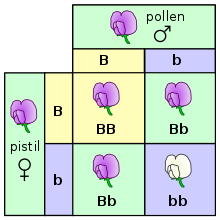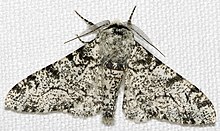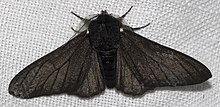Phenotype

The shells of individuals within the bivalve mollusk species Donax variabilis show diverse coloration and patterning in their phenotypes.

Here the relation between genotype and phenotype is illustrated, using a Punnett square, for the character of petal color in pea plants. The letters B and b represent genes for color, and the pictures show the resultant flowers.
The phenotype (from Greek, Modern phainein, meaning 'to show', and typos, meaning 'type') of an organism is the composite of the organism's observable characteristics or traits, including as its morphology or physical form and structure; its developmental processes; its biochemical and physiological properties; its behavior, and the products of behavior, for example, a bird's nest. An organism's phenotype results from two basic factors: the expression of an organism's genetic code, or its genotype, and the influence of environmental factors, which may interact, further affecting phenotype. When two or more clearly different phenotypes exist in the same population of a species, the species is called polymorphic. A well-documented polymorphism is Labrador Retriever coloring; while the coat color depends on many genes, it is clearly seen in the environment as yellow, black and brown. Richard Dawkins in 1978[1] and then again in his 1982 book The Extended Phenotype suggested that bird nests and other built structures such as caddis fly larvae cases and beaver dams can be considered as "extended phenotypes".
The genotype-phenotype distinction was proposed by Wilhelm Johannsen in 1911 to make clear the difference between an organism's heredity and what that heredity produces.[2][3] The distinction is similar to that proposed by August Weismann, who distinguished between germ plasm (heredity) and somatic cells (the body).
The genotype-phenotype distinction should not be confused with Francis Crick's central dogma of molecular biology, which is a statement about the directionality of molecular sequential information flowing from DNA to protein, and not the reverse.
Contents
1 Difficulties in definition
2 Phenotypic variation
2.1 The extended phenotype
3 Phenome and phenomics
4 See also
5 References
6 External links
Difficulties in definition
The term "phenotype" has sometimes been incorrectly used as a shorthand for phenotypic difference from wild type, bringing the absurd statement that a mutation has no phenotype.[4]
Despite its seemingly straightforward definition, the concept of the phenotype has hidden subtleties. It may seem that anything dependent on the genotype is a phenotype, including molecules such as RNA and proteins. Most molecules and structures coded by the genetic material are not visible in the appearance of an organism, yet they are observable (for example by Western blotting) and are thus part of the phenotype; human blood groups are an example. It may seem that this goes beyond the original intentions of the concept with its focus on the (living) organism in itself. Either way, the term phenotype includes traits or characteristics that can be made visible by some technical procedure. A notable extension to this idea is the presence of "organic molecules" or metabolites that are generated by organisms from chemical reactions of enzymes.
Another extension adds behavior to the phenotype, since behaviors are observable characteristics. Behavioral phenotypes include cognitive, personality, and behavioral patterns. Some behavioral phenotypes may characterize psychiatric disorders[5] or syndromes.[6][7]

Biston betularia morpha typica, the standard light-colored peppered moth

B.betularia morpha carbonaria, the melanic form, illustrating discontinuous variation
Phenotypic variation
Phenotypic variation (due to underlying heritable genetic variation) is a fundamental prerequisite for evolution by natural selection. It is the living organism as a whole that contributes (or not) to the next generation, so natural selection affects the genetic structure of a population indirectly via the contribution of phenotypes. Without phenotypic variation, there would be no evolution by natural selection.[8]
The interaction between genotype and phenotype has often been conceptualized by the following relationship:
- genotype (G) + environment (E) → phenotype (P)
A more nuanced version of the relationship is:
- genotype (G) + environment (E) + genotype & environment interactions (GE) → phenotype (P)
Genotypes often have much flexibility in the modification and expression of phenotypes; in many organisms these phenotypes are very different under varying environmental conditions (see ecophenotypic variation). The plant Hieracium umbellatum is found growing in two different habitats in Sweden. One habitat is rocky, sea-side cliffs, where the plants are bushy with broad leaves and expanded inflorescences; the other is among sand dunes where the plants grow prostrate with narrow leaves and compact inflorescences. These habitats alternate along the coast of Sweden and the habitat that the seeds of Hieracium umbellatum land in, determine the phenotype that grows.[9]
An example of random variation in Drosophila flies is the number of ommatidia, which may vary (randomly) between left and right eyes in a single individual as much as they do between different genotypes overall, or between clones raised in different environments.[citation needed]
The concept of phenotype can be extended to variations below the level of the gene that affect an organism's fitness. For example, silent mutations that do not change the corresponding amino acid sequence of a gene may change the frequency of guanine-cytosine base pairs (GC content). These base pairs have a higher thermal stability (melting point) than adenine-thymine, a property that might convey, among organisms living in high-temperature environments, a selective advantage on variants enriched in GC content.[citation needed]
The extended phenotype
Richard Dawkins described a phenotype that included all effects that a gene has on its surroundings, including other organisms, as an extended phenotype, arguing that "An animal's behavior tends to maximize the survival of the genes 'for' that behavior, whether or not those genes happen to be in the body of the particular animal performing it." [1] For instance, an organism such as a beaver modifies its environment by building a beaver dam; this can be considered an expression of its genes, just as its incisor teeth are—which it uses to modify its environment. Similarly, when a bird feeds a brood parasite such as a cuckoo, it is unwittingly extending its phenotype; and when genes in an orchid affect orchid bee behavior to increase pollination, or genes in a peacocks affecting copulatory decisions of peahens, again, the phenotype is being extended. Genes are, in Dawkins's view, selected on by their phenotypic effects.[10]
Other biologists broadly agree that the extended phenotype concept is relevant, but consider that its role is largely explanatory, rather than assisting in the design of experimental tests.[11]
Phenome and phenomics
Although a phenotype is the ensemble of observable characteristics displayed by an organism, the word phenome is sometimes used to refer to a collection of traits, while the simultaneous study of such a collection is referred to as phenomics.[12][13] Phenomics is an important field of study because it can be used to figure out which genomic variants affect phenotypes which then can be used to explain things like health, disease, and evolutionary fitness.[14] Phenomics forms a large part of the Human Genome Project[15]
Phenomics has widespread applications in the agricultural industry. With an exponentially growing population and inconsistent weather patterns due to global warming, it has become increasingly difficult to cultivate enough crops to support the world’s population. Advantageous genomic variations, like drought and heat resistance, can be identified through the use of phenomics to create more durable GMOs.[16][17]
Phenomics is also a crucial stepping stone towards personalized medicine, particularly drug therapy. This application of phenomics has the greatest potential to avoid testing drug therapies that will prove to be ineffective or unsafe.[18] Once the phenomic database has acquired more data, patient phenomic information can be used to select specific drugs tailored to the patient. As the regulation of phenomics develops there is a potential that new knowledge bases will help achieve the promise of personalized medicine and treatment of neuropsychiatric syndromes.
See also
- Ecotype
- Endophenotype
- Genotype
- Genotype-phenotype distinction
- Molecular phenotyping
References
^ ab Dawkins, Richard (12 January 1978). "Replicator Selection and the Extended Phenotype3". Ethology. 47 (1 January–December 1978): 61–76. doi:10.1111/j.1439-0310.1978.tb01823.x. PMID 696023..mw-parser-output cite.citation{font-style:inherit}.mw-parser-output q{quotes:"""""""'""'"}.mw-parser-output code.cs1-code{color:inherit;background:inherit;border:inherit;padding:inherit}.mw-parser-output .cs1-lock-free a{background:url("//upload.wikimedia.org/wikipedia/commons/thumb/6/65/Lock-green.svg/9px-Lock-green.svg.png")no-repeat;background-position:right .1em center}.mw-parser-output .cs1-lock-limited a,.mw-parser-output .cs1-lock-registration a{background:url("//upload.wikimedia.org/wikipedia/commons/thumb/d/d6/Lock-gray-alt-2.svg/9px-Lock-gray-alt-2.svg.png")no-repeat;background-position:right .1em center}.mw-parser-output .cs1-lock-subscription a{background:url("//upload.wikimedia.org/wikipedia/commons/thumb/a/aa/Lock-red-alt-2.svg/9px-Lock-red-alt-2.svg.png")no-repeat;background-position:right .1em center}.mw-parser-output .cs1-subscription,.mw-parser-output .cs1-registration{color:#555}.mw-parser-output .cs1-subscription span,.mw-parser-output .cs1-registration span{border-bottom:1px dotted;cursor:help}.mw-parser-output .cs1-hidden-error{display:none;font-size:100%}.mw-parser-output .cs1-visible-error{font-size:100%}.mw-parser-output .cs1-subscription,.mw-parser-output .cs1-registration,.mw-parser-output .cs1-format{font-size:95%}.mw-parser-output .cs1-kern-left,.mw-parser-output .cs1-kern-wl-left{padding-left:0.2em}.mw-parser-output .cs1-kern-right,.mw-parser-output .cs1-kern-wl-right{padding-right:0.2em}
^ Churchill, F.B. (1974). "William Johannsen and the genotype concept". Journal of the History of Biology. 7: 5–30. doi:10.1007/BF00179291.
^ Johannsen, W. (1911). "The genotype conception of heredity". American Naturalist. 45 (531): 129–159. doi:10.1086/279202. JSTOR 2455747. PMC 4258772.
^ Crusio, Wim E. (May 2002). "'My mouse has no phenotype'". Genes, Brain and Behavior. 1 (2): 71. doi:10.1034/j.1601-183X.2002.10201.x. PMID 12884976. Retrieved 2009-12-29.
^ Cassidy, Suzanne B.; Morris, Colleen A. (2002-01-01). "Behavioral phenotypes in genetic syndromes: genetic clues to human behavior". Advances in Pediatrics. 49: 59–86. PMID 12214780.
^ O'Brien, Gregory; Yule, William, eds. (1995). Behavioural Phenotype. Clinics in Developmental Medicine No.138. London: Mac Keith Press. ISBN 1-898683-06-9.
^ O'Brien, Gregory, ed. (2002). Behavioural Phenotypes in Clinical Practice. London: Mac Keith Press. ISBN 1-898683-27-1. Retrieved 27 September 2010.
^ Lewontin, R. C. (November 1970). "The Units of Selection" (PDF). Annual Review of Ecology and Systematics. 1: 1–18. doi:10.1146/annurev.es.01.110170.000245. JSTOR 2096764.
^ "Botany online: Evolution: The Modern Synthesis - Phenotypic and Genetic Variation; Ecotypes". Archived from the original on 2009-06-18. Retrieved 2009-12-29.
^ Dawkins, Richard (1982). The Extended Phenotype. Oxford University. p. 4. ISBN 0-19-288051-9.
^ Hunter, Philip (2009). "Extended phenotype redux. How far can the reach of genes extend in manipulating the environment of an organism?". EMBO Reports. 10 (3): 212–215. doi:10.1038/embor.2009.18. PMC 2658563.
^ Mahner, M. & Kary, M. (1997). "What exactly are genomes, genotypes and phenotypes? And what about phenomes?". Journal of Theoretical Biology. 186: 55–63. doi:10.1006/jtbi.1996.0335.
^ Varki, A; Wills, C; Perlmutter, D; Woodruff, D; Gage, F; Moore, J; Semendeferi, K; Bernirschke, K; Katzman, R; et al. (1998). "Great Ape Phenome Project?". Science. 282 (5387): 239–240. Bibcode:1998Sci...282..239V. doi:10.1126/science.282.5387.239d. PMID 9841385.
^ Houle, David; Govindaraju, Diddahally R.; Omholt, Stig (December 2010). "Phenomics: the next challenge". Nature Reviews Genetics. 11 (12): 855–866. doi:10.1038/nrg2897. PMID 21085204.
^ Freimer, Nelson; Sabatti, Chiara (May 2003). "The Human Phenome Project". Nature Genetics. 34 (1): 15–21. doi:10.1038/ng0503-15. PMID 12721547.
^ Rahman, Hifzur; Ramanathan, Valarmathi; Jagadeeshselvam, N.; Ramasamy, Sasikala; Rajendran, Sathishraj; Ramachandran, Mahendran; Sudheer, Pamidimarri D. V. N.; Chauhan, Sushma; Natesan, Senthil (2015-01-01). Barh, Debmalya; Khan, Muhammad Sarwar; Davies, Eric, eds. PlantOmics: The Omics of Plant Science. Springer India. pp. 385–411. doi:10.1007/978-81-322-2172-2_13#page-1. ISBN 9788132221715.
^ Furbank, Robert T.; Tester, Mark (2011-12-01). "Phenomics – technologies to relieve the phenotyping bottleneck". Trends in Plant Science. 16 (12): 635–644. doi:10.1016/j.tplants.2011.09.005.
^ Monte, Andrew A.; Brocker, Chad; Nebert, Daniel W.; Gonzalez, Frank J.; Thompson, David C.; Vasiliou, Vasilis (2014-12-01). "Improved drug therapy: triangulating phenomics with genomics and metabolomics". Human Genomics. 8 (1): 16. doi:10.1186/s40246-014-0016-9. PMC 4445687. PMID 25181945.
External links
| Wikimedia Commons has media related to Phenotypes. |
- Mouse Phenome Database
- Human Phenotype Ontology
- Europhenome: Access to raw and annotated mouse phenotype data
- "Wilhelm Johannsen's Genotype-Phenotype Distinction" by E. Peirson at the Embryo Project Encyclopedia